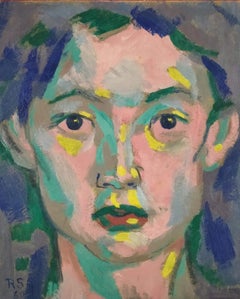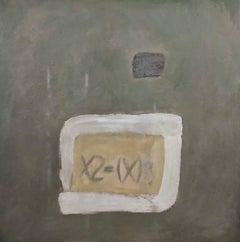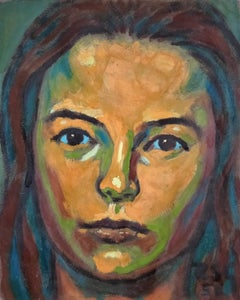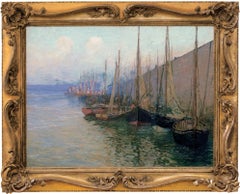Gabino Rey Santiago
Spanish, 1928-2006
Spanish painter who continued the tradition of realist and impressionist painting at the beginning of the 20th century, developed in the landscape, portrait and still life genres. With the beginning of the Civil War, he moved with his family to Barcelona, where he began his pictorial training from an early age. In 1943, at the age of fourteen, he painted a self-portrait with which he won First Prize at the I Youth Salon of the Dalmau Galleries. Despite participating in the gatherings of the artists who would form the innovative and disruptive group Dau al Set, Gabino chose to follow his personal path under the teachings of drawing teacher Ramon Rogent. In 1945 the French Institute granted him a scholarship in Paris, which he was not able to enjoy, and two years later he withdrew from painting until 1957, when he resumed his artistic activity. In his work he opts for a figuration, faithful to the naturalistic interpretation of reality, through a loose brushstroke, which translates light and color in a style inherited from Spanish impressionism and post-impressionism.
Since 1957, the year he exhibited for the first time at the Sala Parés in Barcelona, his exhibition activity was linked to this gallery, also holding exhibitions at the El Cisne Gallery (Madrid, 1968) as well as in Lugo, Pontevedra, Alicante/Alacant and, outside Spain, in Los Angeles, New York or Paris. Among the recognitions obtained during his professional career, the First Prize at the III International Exhibition of the Bilbao Art Union (1947) stands out.(Biography provided by Galeria Sastre s l)
1
to
6
6
4
2
2
2
2
Barcelona fishing port oil on canvas painting spanish seascape
Located in Barcelona, Barcelona
Gabino Rey Santiago (1928-2006) - Oil on canvas - Port of Barcelona
Oil measures 54x65 cm.
Frameless.
Category
1980s Impressionist Gabino Rey Santiago
Materials
Oil, Canvas
Untitled
Located in Barcelona, ES
The painting is being offered with a work and authenticity certificate
Category
1960s Modern Gabino Rey Santiago
Materials
Paper, Mixed Media
Untitled
Located in Barcelona, ES
The painting is being offered with a work and authenticity certificate
Category
1960s Abstract Gabino Rey Santiago
Materials
Canvas, Oil
Untitled
Located in Barcelona, ES
The painting is being offered with a work and authenticity certificate
Category
1980s Abstract Gabino Rey Santiago
Materials
Oil, Wood
Untitled
Located in Barcelona, ES
The painting is being offered with a work and authenticity certificate
Category
1950s Modern Gabino Rey Santiago
Materials
Paper, Mixed Media
Untitled
Located in Barcelona, ES
The painting is being offered with a work and authenticity certificate
Category
1950s Modern Gabino Rey Santiago
Materials
Mixed Media, Paper
Related Items
"Winter Storm, NYC"
By Johann Berthelsen, 1883-1972
Located in Lambertville, NJ
Jim’s of Lambertville Fine Art Gallery is proud to offer this piece by Johann Berthelsen (1883 – 1972).
Born in 1883 in Denmark to artistically inclined parents, Johann Berthelsen would become a widely successful singer, teacher, and painter. After his parents divorced, his mother brought Berthelsen and his siblings with her to the United States in 1890, eventually settling in Wisconsin.
At eighteen, Berthelsen moved to Chicago in the hope of becoming an actor, but a friend at the Chicago Musical College convinced him to audition at his school. Berthelsen received a full scholarship and enrolled at the college, where he was awarded the Gold Medal twice. After graduating, he had an active career traveling across the United States and Canada performing in operas and concerts, before joining the voice faculty at his alma mater in 1910. In 1913, Berthelsen became the voice department director at the Indianapolis Conservatory of Music.
While in Chicago, Berthelsen met the landscape painter, Svend Svendsen...
Category
20th Century American Impressionist Gabino Rey Santiago
Materials
Oil, Canvas
"In Port"
By Edward Willis Redfield
Located in Lambertville, NJ
Jim’s of Lambertville is proud to offer this artwork by:
Edward Willis Redfield (1869 - 1965)
Edward W. Redfield was born in Bridgeville, Delaware, moving to Philadelphia as a young child. Determined to be an artist from an early age, he studied at the Spring Garden Institute and the Franklin Institute before entering the Pennsylvania Academy from 1887 to 1889, where he studied under Thomas Anshutz, James Kelly, and Thomas Hovenden. Along with his friend and fellow artist, Robert Henri, he traveled abroad in 1889 and studied at the Academie Julian in Paris under William Bouguereau and Tony Robert-Fleury. While in France, Redfield met Elise Deligant, the daughter of an innkeeper, and married in London in 1893.
Upon his return to the United States, Redfield and his wife settled in Glenside, Pennsylvania. He remained there until 1898, at which time he moved his family to Center Bridge, a town several miles north of New Hope along the Delaware River. Redfield painted prolifically in the 1890s but it was not until the beginning of the twentieth century that he would develop the bold impressionist style that defined his career. As Redfield’s international reputation spread, many young artists gravitated to New Hope as he was a great inspiration and an iconic role model. Edward Redfield remained in Center Bridge throughout his long life, fathering his six children there.
Around 1905 and 1906, Redfield’s style was coming into its own, employing thick vigorous brush strokes tightly woven and layered with a multitude of colors. These large plein-air canvases define the essence of Pennsylvania Impressionism. By 1907, Redfield had perfected his craft and, from this point forward, was creating some of his finest work.
Redfield would once again return to France where he painted a small but important body of work between 1907 and 1908. While there, he received an Honorable Mention from the Paris Salon for one of these canvases. In 1910 he was awarded a Gold Medal at the prestigious Buenos Aires Exposition and at the Panama-Pacific Exposition of 1915 in San Francisco, an entire gallery was dedicated for twenty-one of his paintings.
Since Redfield painted for Exhibition with the intent to win medals, his best effort often went into his larger paintings. Although he also painted many fine smaller pictures, virtually all of his works were of major award-winning canvas sizes of 38x50 or 50x56 inches. If one were to assign a period of Redfield’s work that was representative of his “best period”, it would have to be from 1907 to 1925. Although he was capable of creating masterpieces though the late 1940s, his style fully matured by 1907 and most work from then through the early twenties was of consistently high quality. In the later 1920s and through the 1930s and 1940s, he was like most other great artists, creating some paintings that were superb examples and others that were of more ordinary quality.
Redfield earned an international reputation at a young age, known for accurately recording nature with his canvases and painting virtually all of his work outdoors; Redfield was one of a rare breed. He was regarded as the pioneer of impressionist winter landscape painting in America, having few if any equals. Redfield spent summers in Maine, first at Boothbay Harbor and beginning in the 1920s, on Monhegan Island. There he painted colorful marine and coastal scenes as well as the island’s landscape and fishing shacks. He remained active painting and making Windsor style furniture...
Category
Early 1900s American Impressionist Gabino Rey Santiago
Materials
Canvas, Oil
"Manhattan Night Life"
By Vaclav Vytlacil
Located in Lambertville, NJ
Jim’s of Lambertville is proud to offer this artwork by:
Vaclav Vytlacil (1892-1984)
He was born to Czechoslovakian parents in 1892 in New York City. Living in Chicago as a youth, he took classes at the School of the Art Institute of Chicago, returning to New York when he was 20. From 1913 to 1916, he enjoyed a scholarship from the Art Students League, and worked with John C. Johansen (a portraitist whose expressive style resembled that of John Singer Sargent), and Anders Zorn.
He accepted a teaching position at the Minneapolis School of Art in 1916, remaining there until 1921. This enabled him to travel to Europe to study Cézanne’s paintings and works of the Old Masters. He traveled to Paris, Prague, Dresden, Berlin, and Munich seeking the works of Titian, Cranach, Rembrandt, Veronese, and Holbein, which gave him new perspective. Vytlacil studied at the Royal Academy of Art in Munich, settling there in 1921. Fellow students were Ernest Thurn and Worth Ryder, who introduced him to famous abstractionist Hans Hofmann. He worked with Hofmann from about 1922 to 1926, as a student and teaching assistant.
During the summer of 1928, after returning to the United States, Vytlacil gave lectures at the University of California, Berkeley, on modern European art. Soon thereafter, he became a member of the Art Students League faculty. After one year, he returned to Europe and successfully persuaded Hofmann to teach at the League as well. He spent about six years in Europe, studying the works of Matisse, Picasso, and Dufy. In 1935, he returned to New York and became a co-founder of the American Abstract Artists group in 1936. He later had teaching posts at Queens College in New York; the College of Arts and Crafts in Oakland, California; Black Mountain College in North Carolina; and the Art Students League.
His paintings exhibit a clear inclination toward modernism. His still lives and interiors from the 1920s indicate an understanding of the art of Cézanne. In the 1930s, his works displayed two very different kinds of art at the same time. His cityscapes and landscapes combine Cubist-inspired spatial concerns with an expressionistic approach to line and color. Vytlacil also used old wood, metal, cork, and string in constructions, influenced by his friend and former student, Rupert Turnbull. He eventually ceased creating constructions as he considered them too limiting. The spatial challenges of painting were still his preference. During the 1940s and 1950s, his works indicated a sense of spontaneity not felt in his earlier work.
He married Elizabeth Foster in Florence, Italy, in 1927 and they lived and worked in Positano, Italy for extended periods of time. Later on, they divided their time between homes in Sparkill, New York and Chilmark, Massachusetts, where Vyt, as he was affectionately called, taught at the Martha's Vineyard Art...
Category
1930s Abstract Expressionist Gabino Rey Santiago
Materials
Canvas, Oil
"The Neighbors"
By George William Sotter
Located in Lambertville, NJ
Jim’s of Lambertville is proud to offer this artwork.
Signed lower right and is Illustrated in the Ashley John Gallery catalog titled "The Pennsylvania Impressionists".
George William Sotter (1879 - 1953)
Born in Pittsburgh on September 25, 1879, Sotter began his art education with local teachers and with Henry G. Keller, who had studied in various German academies. Keller, known for his superb, atmospheric watercolors, taught at the Cleveland School of Art but Sotter studied with him in Pittsburgh. Later Sotter would exhibit between 1903 and 1937 at the Pennsylvania Academy of the Fine Arts. His works were also shown at the Corcoran Gallery (1912-23), the Carnegie International (1901-26), the National Academy of Design (1913 and 1921), and at the Art Institute of Chicago (1911-27). In 1915, Sotter exhibited four works at the Panama-Pacific International Exposition in San Francisco, where he won a silver medal. Sotter was known mainly as a stained-glass artist; his work may be seen from New York City to Salt Lake City. Around a dozen craftsmen worked under him for these commissions.
Sotter spent the summer of 1902 with Pennsylvania impressionist Edward Redfield in Boothbay Harbor, Maine. Between 1910 and 1919, Sotter taught at the Carnegie Institute of Technology. His paintings often feature large areas of sky filled with clouds and he frequently painted winter night scenes, such as Moonlight, Bucks County (Beacon Hill Fine Art), a perfectly successful depiction of a quiet, moonlit landscape filled with twinkling stars. Star-studded skies, although rare in landscape painting, go back at least to 1600 when they appear in the oeuvre of Adam Elsheimer...
Category
20th Century American Impressionist Gabino Rey Santiago
Materials
Oil, Canvas
Winter Moonlight
By George William Sotter
Located in Lambertville, NJ
signed lower right
Category
1910s American Impressionist Gabino Rey Santiago
Materials
Canvas, Oil
Ripples in Space - Abstract Composition Original Oil Painting
Located in Soquel, CA
Ripples in Space - Abstract Composition Original Oil Painting
Vibrant abstract composition of paint, paper, enamel, and glitter by unknown artist "DeZulio" or "Dejulio". Several pie...
Category
Late 20th Century Abstract Gabino Rey Santiago
Materials
Enamel
H 24.75 in W 38 in D 1 in
"The Auction"
By Robert Spencer
Located in Lambertville, NJ
Jim’s of Lambertville is proud to offer this artwork by:
Robert Spencer (1879 - 1931)
One of the rarest and most important artists among the New Hope School, Robert Spencer was bor...
Category
1910s American Impressionist Gabino Rey Santiago
Materials
Oil, Canvas
"Forest Strongholds"
By John F. Carlson
Located in Lambertville, NJ
Signed lower right. Complemented by a hand carved and gilt frame.
Exhibited at the National Academy of Design, 1928
Category
20th Century American Impressionist Gabino Rey Santiago
Materials
Canvas, Oil
Antidote from the Gods
Located in Ibadan, Oyo
Climate change is a serious issue that we must all work together to address. One key solution is the planting of trees. Trees help to absorb carbon dioxide from the atmosphere, which...
Category
2010s Modern Gabino Rey Santiago
Materials
Fabric, Canvas, Charcoal, Acrylic, Pencil, Mixed Media
"Solebury Valley"
By William Langson Lathrop
Located in Lambertville, NJ
Signed lower right.
Complemented by a period frame.
William L. Lathrop (1859-1938)
Deemed “Father of the New Hope Art Colony”, William Langson Lathrop was born in Warren, Illinois. He was largely self-taught, having only studied briefly with William Merritt Chase in 1887, at the Art Students League. Lathrop first moved east in the early 1880s, and took a job at the Photoengraving Company in New York City. While there, he befriended a fellow employee, Henry B. Snell. The two men became lifelong friends and ultimately, both would be considered central figures among the New Hope Art Colony.
Lathrop's early years as an artist were ones of continuing struggle. His efforts to break through in the New York art scene seemed futile, so he scraped enough money together to travel to Europe with Henry Snell in1888. There he met and married an English girl, Annie Burt. Upon returning to New York, he tried his hand at etching, making tools from old saw blades...
Category
1910s American Impressionist Gabino Rey Santiago
Materials
Canvas, Oil
"Road to Argus"
By Walter Emerson Baum
Located in Lambertville, NJ
Jim’s of Lambertville Fine Art Gallery is proud to offer this piece by Walter Emerson Baum (1884 - 1956).
Born in Sellersville, Pennsylvania, Walter Baum was one of the only members...
Category
1930s American Impressionist Gabino Rey Santiago
Materials
Oil, Canvas
The Bather by Childe Hassam
By Childe Hassam
Located in New Orleans, LA
Childe Hassam
1859-1935 American
The Bather
Signed and dated “Childe Hassam” (lower right)
Oil on canvas
Considered by many to be America’s foremost Impressionist painter, Childe Hassam composed his tranquil and intimate oil on canvas The Bather in the early years of the 20th century. The creation of the artwork aligns with a period of Hassam’s career where the artist’s palette was transforming, matching ever closer with the pale and pastel hues of French Impressionists like Claude Monet. Even the subject — a nude woman — represents a greater alignment with the Impressionist project, as artists of the movement and their non-mythological and non-biblical nudes still generated cries of indecency. With Hassam’s signature brushwork and attention to color, The Bather serves as a dream-like vision, serene and sensuous, of a young woman bathing in a lush forest.
While the artist's skill for landscape painting is on display, it is Hassam's command of form, light and color that brings this canvas to life. He creates a captivating composition, placing the nude subject in the bottom left of the canvas. The soft, undulating curves of the woman's body in contrapposto and the glow of her fair skin are balanced by the strong verticals and deep earth tones of the tall trees to her right. Hassam delicately frames the nude in the vivid blues of the distant water, building luminous color that further draws the viewer’s eye and results in a somewhat voyeuristic appeal — endowing his nude with both a natural innocence and an intentional sensuality.
Born in Dorchester, Massachusetts, Childe Hassam began his artistic career as a freelance illustrator, working for national publications such as Harper’s Weekly, Scribner’s Monthly, and The Century. His first solo exhibition of watercolors took place in Boston in 1883, and he quickly catapulted onto the international scene, winning a bronze medal at the Exposition Universelle in Paris in 1889. The year before the present work was created, he received the Webb Prize from the Society of American Artists for another landscape painted at Gloucester. Hassam would receive numerous other awards throughout his career, most notably the Gold Medal for Distinguished Services to Fine Art from the American Dealers Association. A true master, Hassam depicted a way of life characteristic of both American and French society, and his work elucidates a critical chapter in American art history. Today, his work resides in the Oval Office of the White House and in numerous important museums, including the Metropolitan Museum of Art in New York, the National Gallery of Art in Washington, DC and the Museum of Fine Arts in Boston, among others.
This painting will be included in Stuart P. Feld's and Kathleen M. Burnside's forthcoming catalogue raisonné of the artist's work.
Circa 1905
Canvas: 24 1/2“ high x 20 18” wide
Frame: 35 7/8“ high x 31 1/4” wide x 3 1/4“ deep
Provenance:
Private Collection of William Young...
Category
20th Century Impressionist Gabino Rey Santiago
Materials
Oil, Canvas
Gabino Rey Santiago art for sale on 1stDibs.
Find a wide variety of authentic Gabino Rey Santiago art available for sale on 1stDibs. You can also browse by medium to find art by Gabino Rey Santiago in mixed media, oil paint, paint and more. Much of the original work by this artist or collective was created during the 20th century and is mostly associated with the modern style. Not every interior allows for large Gabino Rey Santiago art, so small editions measuring 10 inches across are available. Gabino Rey Santiago art prices can differ depending upon medium, time period and other attributes. On 1stDibs, the price for these items starts at $1,414 and tops out at $3,698, while the average work can sell for $1,450.






